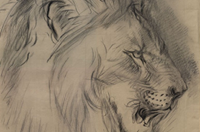Ruskin's Standard & Reference series (1872)
Exemplary works of art. In the catalogue of the Reference series, items marked 'M' are drawings "by my own Hand" (by Ruskin), P are photographs, E engravings and A by Ruskin's Assistant, Arthur Burgess.

Ruskin's Catalogues: 1 object
Show search helpView from the Palazzo Bembo to the Palazzo Grimani, Venice John Ruskin
-
Ruskin text
66 Casa Manin and Casa Grimani, Venice. Sketched in 1870 M -
Curator’s description:
Description
The drawing shows the south bank of the Grand Canal, looking towards the Saint Mark's end. It is taken from a point just off the Rialto Bridge, and moored in front of the Palazzo Manin, which is not therefore in the picture, despite Ruskin having titled it 'Casa Manin and Casa Grimani' in the Standard and Reference Series catalogue. The bridge visible on the left crosses the Rio di San Salvatore, and the large palace on the left edge is the Palazzo Bembo. The Palazzo Grimani (now the Corte d'Appello) is the building with the tall facade topped by a heavy entablature shown in steep perspective about a third of the width of the drawing from the right edge; the broad front of the Ca' Foscari can be seen on the opposite bank as the canal bends to the left.
In his catalogue entry for the picture, Ruskin notes that he drew it in 1870; Taylor narrows the period down to May to June. It seems that the picture cannot be identified with no. 16.R in the 1878 Turner exhibition, 'View of the Upper Reach of the Grand Canal, looking north ...', as proposed by Cook and Wedderburn (XIII.500 n. 2), as this drawing shows the lower reach, looking south. Neither can it be no. 15.R, proposed by Hewison in the exhibition catalogue "Ruskin and Venice", as that showed the 'View from Ca' Bernardo to Ca' Grimani' - and the Palazzo Bernardo is in fact directly opposite the Palazzo Grimani; Cook and Wedderburn describe this drawing as being at Brantwood (Catalogue, no. 296). The drawing first appears in the Oxford collections as no. 66 in the Standard and Reference Series catalogue of 1872, where it was accompanied by other drawings of buildings in Abbeville, Verona and Venice.
Ruskin thought the Palazzo Bembo 'A noble Gothic pile', with a Byzantine ground floor and mezzanine; he decried the fact that its upper storeys had been whitewashed, its lower one turned into a coal warehouse. (Venetian Index = XI.364). The Palazzo Grimani contained the apartment where Rawdon Brown lived towards the end of his life, and died (X.xxvii-xxviii). Ruskin considered it to be the noblest 'Roman Renaissance' building in Venice, with 'not an erring line, nor a mistaken proportion, throughout its noble front', its decoration 'sparing, but delicate' (Stones of Venice, vol. III, ch. ii, § 1 = XI.43-4).
On 10 September 1845, Ruskin lamented the state of the Ca' Foscari: 'The Foscari palace is all but a total ruin - the rents in its walls are half a foot wide' (IV.40-1 n. 4); a few years later, although parising its restoration, he decried its use as an Austrian barracks, fearing its condition would soon deteriorate again. He considered it 'The noblest example in Venice of the fifteenth century Gothic ... lately restored and spoiled, all but the stonework of the main windows.' ( Venetian Index = XI.378.)
-
Details
- Artist/maker
-
John Ruskin (1819 - 1900)
- Object type
- drawing
- Material and technique
- graphite and watercolour on paper
- Dimensions
- 353 x 508 mm
- Associated place
-
- Europe › Italy › Veneto (Venetia) › Venice › Ca' Foscari › Ca' Foscari (subject)
- Europe › Italy › Veneto (Venetia) › Venice › Palazzo Grimani di San Luca › Palazzo Grimani di San Luca (subject)
- Europe › Italy › Veneto (Venetia) › Venice › Palazzo Bembo › Palazzo Bembo (subject)
- Provenance
-
Presented by John Ruskin to the Ruskin Drawing School (University of Oxford), 1875; transferred from the Ruskin Drawing School to the Ashmolean Museum, c.1949.
- No. of items
- 1
- Accession no.
- WA.RS.REF.066
-
Subject terms allocated by curators:
Subjects
-
References in which this object is cited include:
References
Taylor, Gerald, ‘John Ruskin: A Catalogue of Drawings by John Ruskin in the Ashmolean Museum, Oxford’, 7 fascicles, 1998, Oxford, Ashmolean Museum, no. 146
Cook, Edward T., Studies in Ruskin: Some Aspects of the Work and Teaching of John Ruskin (Orpington: George Allen, 1890), pl. VII, f.p. 312
Ruskin, John, Catalogue of the Reference Series Including Temporarily the First Section of the Standard Series (London: Smith, Elder, [1872]), cat. Reference no. 66
Ruskin, John, ‘The Works of John Ruskin’, Edward T. Cook and Alexander Wedderburn, eds, The Works of John Ruskin: Library Edition, 39 (London: George Allen, 1903-1912), vol. XXI, pl. XXVII, f.p. 31
Ruskin, John, ‘The Ruskin Art Collection at Oxford: Catalogues, Notes and Instructions’, Edward T. Cook and Alexander Wedderburn, eds, The Works of John Ruskin: Library Edition, 39 (London: George Allen, 1903-1912), 21, cat. Reference no. 66
Location
-
- Western Art Print Room
Position in Ruskin’s Collection
Ruskin's Catalogues
-
Ruskin's Standard & Reference series (1872)
66 Casa Manin and Casa Grimani, Venice. Sketched in 1870 M





